Process Control: System Modeling and Identification Research Report
VerifiedAdded on 2022/08/13
|7
|2012
|14
Report
AI Summary
This report provides a comprehensive overview of process control, focusing on system modeling and identification techniques. It explores the challenges of modeling nonlinear systems, highlighting the use of the Multimodel Framework (MMF) and its various paradigms, including PWC, LPV, and T-S fuzzy models. The report delves into different partition strategies, such as operating point linearization (OPL) and sector nonlinearity, as well as data-based partitioning methods. It also examines the application of Volterra series for nonlinear system identification and the use of piezoelectric actuators in nanopositioning. The report discusses various control techniques, including feedforward and feedback control, and addresses the importance of accurate system modeling for achieving high performance. The analysis includes a review of relevant research papers and the advantages and disadvantages of the techniques used, along with suggestions for improvement.
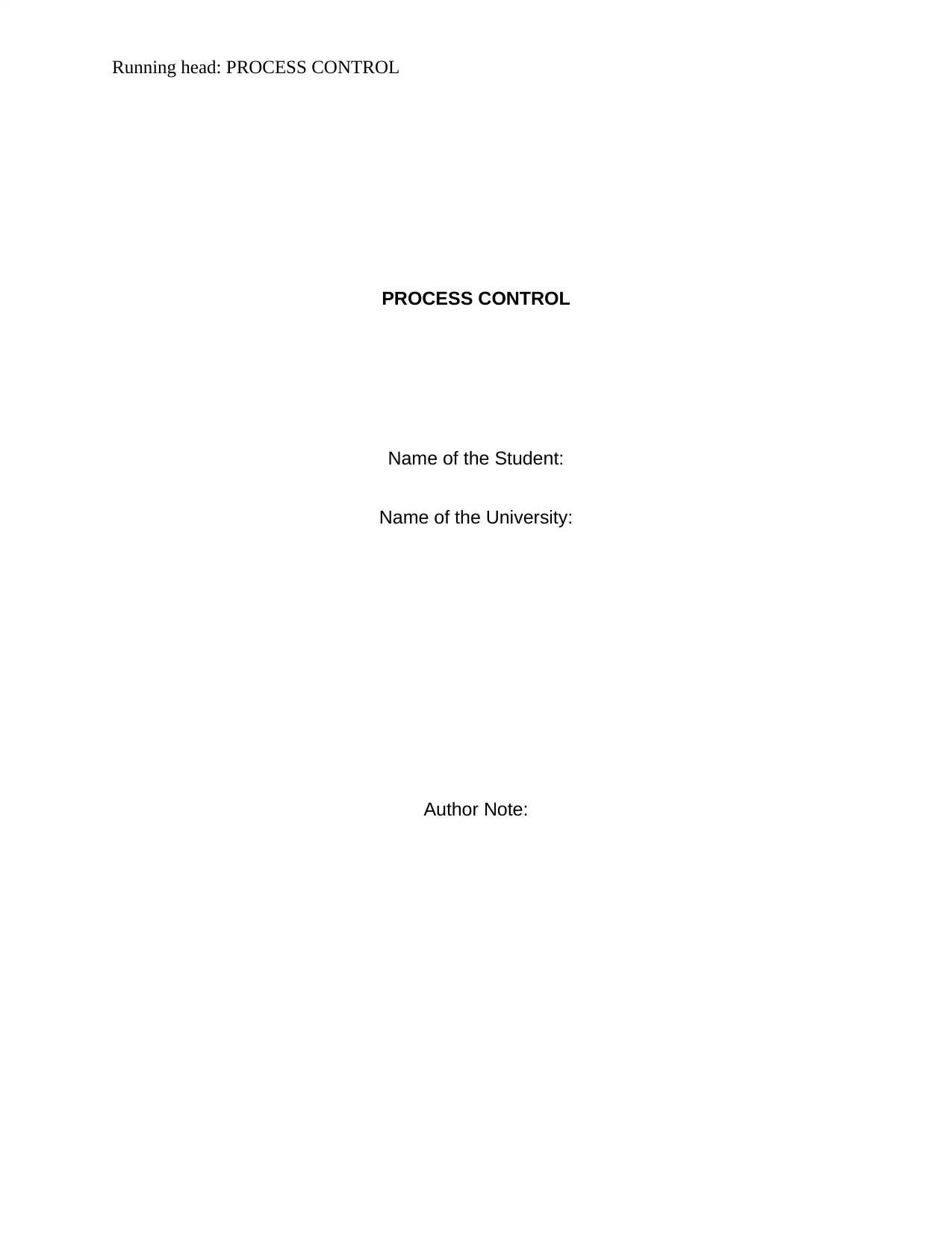
Running head: PROCESS CONTROL
PROCESS CONTROL
Name of the Student:
Name of the University:
Author Note:
PROCESS CONTROL
Name of the Student:
Name of the University:
Author Note:
Paraphrase This Document
Need a fresh take? Get an instant paraphrase of this document with our AI Paraphraser
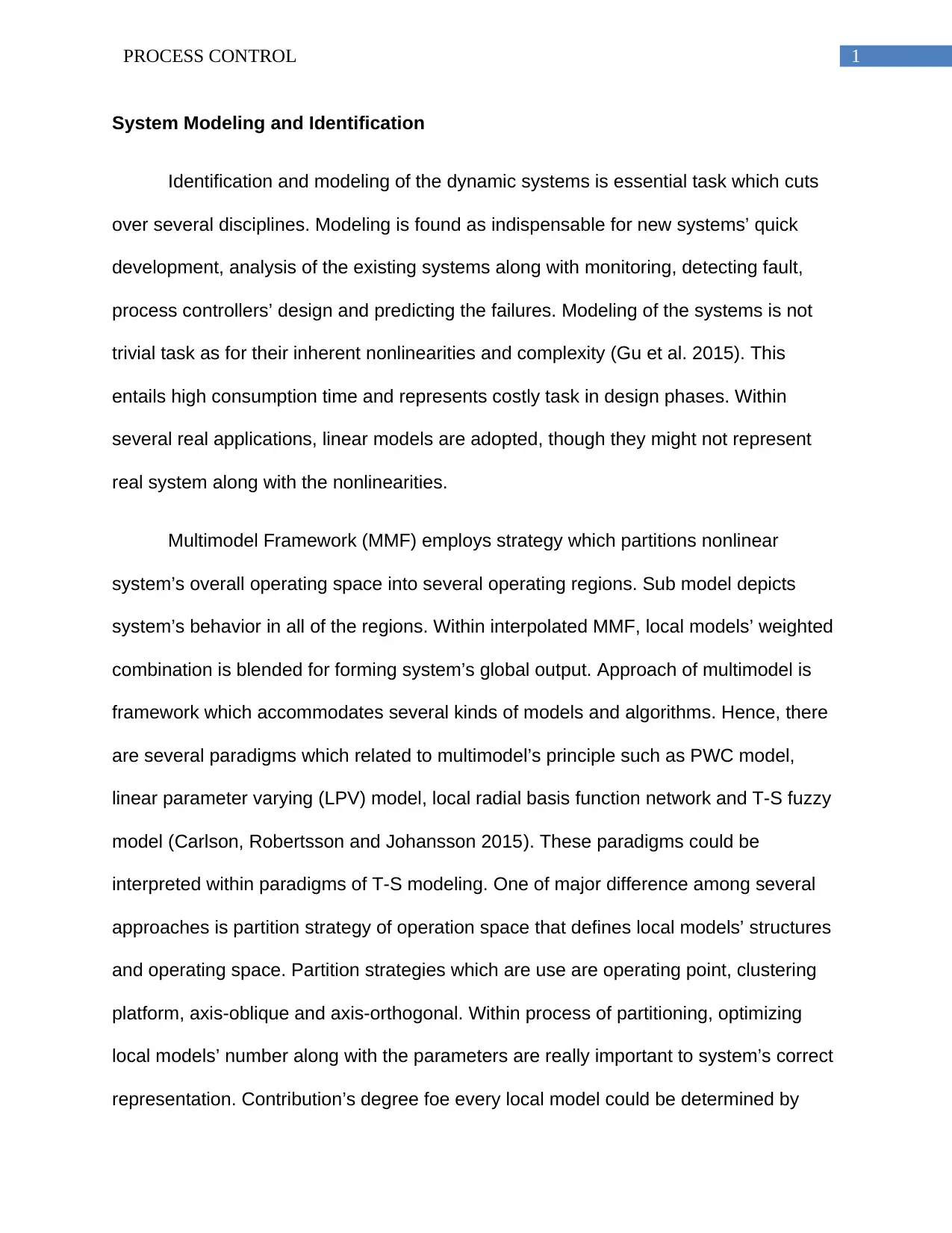
1PROCESS CONTROL
System Modeling and Identification
Identification and modeling of the dynamic systems is essential task which cuts
over several disciplines. Modeling is found as indispensable for new systems’ quick
development, analysis of the existing systems along with monitoring, detecting fault,
process controllers’ design and predicting the failures. Modeling of the systems is not
trivial task as for their inherent nonlinearities and complexity (Gu et al. 2015). This
entails high consumption time and represents costly task in design phases. Within
several real applications, linear models are adopted, though they might not represent
real system along with the nonlinearities.
Multimodel Framework (MMF) employs strategy which partitions nonlinear
system’s overall operating space into several operating regions. Sub model depicts
system’s behavior in all of the regions. Within interpolated MMF, local models’ weighted
combination is blended for forming system’s global output. Approach of multimodel is
framework which accommodates several kinds of models and algorithms. Hence, there
are several paradigms which related to multimodel’s principle such as PWC model,
linear parameter varying (LPV) model, local radial basis function network and T-S fuzzy
model (Carlson, Robertsson and Johansson 2015). These paradigms could be
interpreted within paradigms of T-S modeling. One of major difference among several
approaches is partition strategy of operation space that defines local models’ structures
and operating space. Partition strategies which are use are operating point, clustering
platform, axis-oblique and axis-orthogonal. Within process of partitioning, optimizing
local models’ number along with the parameters are really important to system’s correct
representation. Contribution’s degree foe every local model could be determined by
System Modeling and Identification
Identification and modeling of the dynamic systems is essential task which cuts
over several disciplines. Modeling is found as indispensable for new systems’ quick
development, analysis of the existing systems along with monitoring, detecting fault,
process controllers’ design and predicting the failures. Modeling of the systems is not
trivial task as for their inherent nonlinearities and complexity (Gu et al. 2015). This
entails high consumption time and represents costly task in design phases. Within
several real applications, linear models are adopted, though they might not represent
real system along with the nonlinearities.
Multimodel Framework (MMF) employs strategy which partitions nonlinear
system’s overall operating space into several operating regions. Sub model depicts
system’s behavior in all of the regions. Within interpolated MMF, local models’ weighted
combination is blended for forming system’s global output. Approach of multimodel is
framework which accommodates several kinds of models and algorithms. Hence, there
are several paradigms which related to multimodel’s principle such as PWC model,
linear parameter varying (LPV) model, local radial basis function network and T-S fuzzy
model (Carlson, Robertsson and Johansson 2015). These paradigms could be
interpreted within paradigms of T-S modeling. One of major difference among several
approaches is partition strategy of operation space that defines local models’ structures
and operating space. Partition strategies which are use are operating point, clustering
platform, axis-oblique and axis-orthogonal. Within process of partitioning, optimizing
local models’ number along with the parameters are really important to system’s correct
representation. Contribution’s degree foe every local model could be determined by
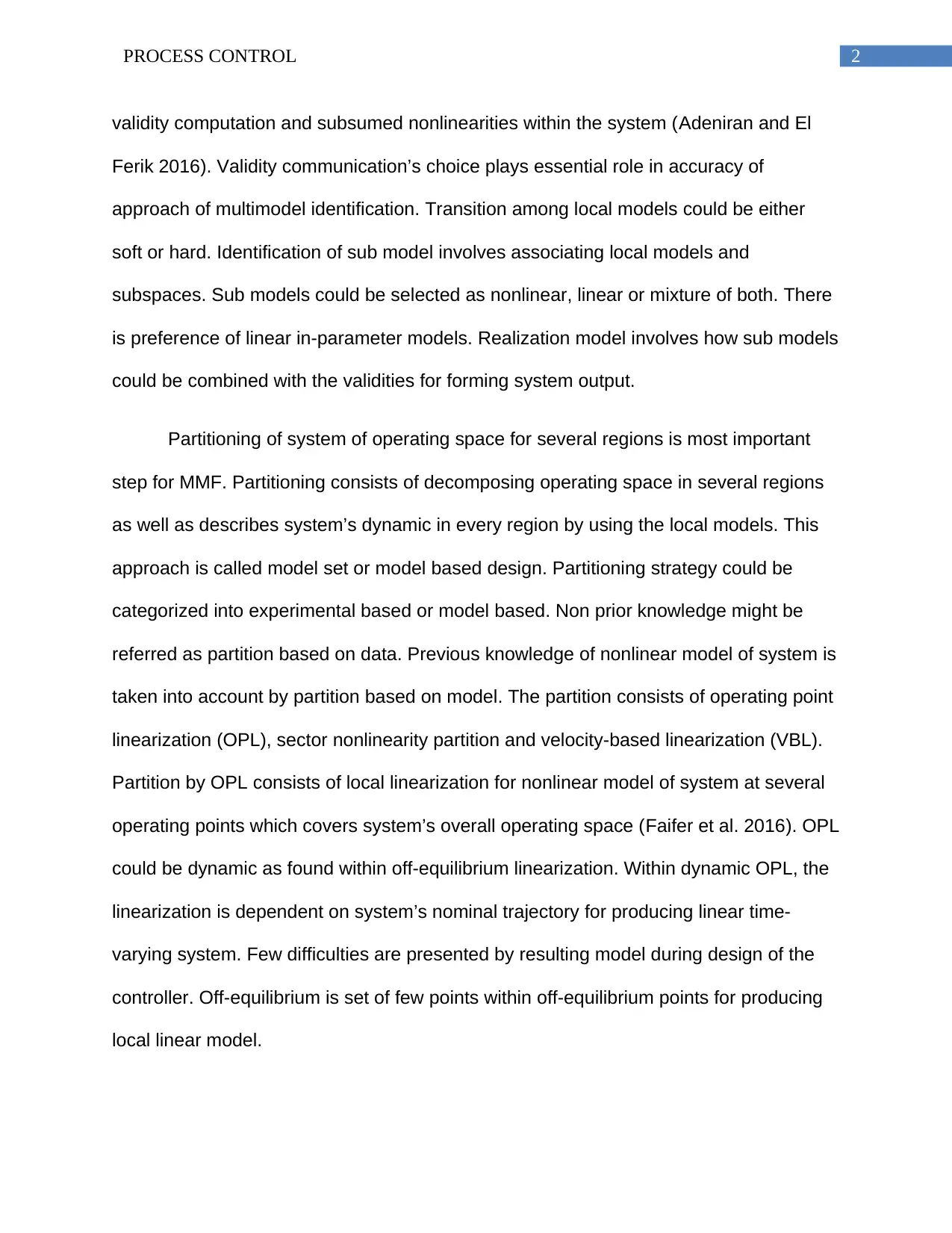
2PROCESS CONTROL
validity computation and subsumed nonlinearities within the system (Adeniran and El
Ferik 2016). Validity communication’s choice plays essential role in accuracy of
approach of multimodel identification. Transition among local models could be either
soft or hard. Identification of sub model involves associating local models and
subspaces. Sub models could be selected as nonlinear, linear or mixture of both. There
is preference of linear in-parameter models. Realization model involves how sub models
could be combined with the validities for forming system output.
Partitioning of system of operating space for several regions is most important
step for MMF. Partitioning consists of decomposing operating space in several regions
as well as describes system’s dynamic in every region by using the local models. This
approach is called model set or model based design. Partitioning strategy could be
categorized into experimental based or model based. Non prior knowledge might be
referred as partition based on data. Previous knowledge of nonlinear model of system is
taken into account by partition based on model. The partition consists of operating point
linearization (OPL), sector nonlinearity partition and velocity-based linearization (VBL).
Partition by OPL consists of local linearization for nonlinear model of system at several
operating points which covers system’s overall operating space (Faifer et al. 2016). OPL
could be dynamic as found within off-equilibrium linearization. Within dynamic OPL, the
linearization is dependent on system’s nominal trajectory for producing linear time-
varying system. Few difficulties are presented by resulting model during design of the
controller. Off-equilibrium is set of few points within off-equilibrium points for producing
local linear model.
validity computation and subsumed nonlinearities within the system (Adeniran and El
Ferik 2016). Validity communication’s choice plays essential role in accuracy of
approach of multimodel identification. Transition among local models could be either
soft or hard. Identification of sub model involves associating local models and
subspaces. Sub models could be selected as nonlinear, linear or mixture of both. There
is preference of linear in-parameter models. Realization model involves how sub models
could be combined with the validities for forming system output.
Partitioning of system of operating space for several regions is most important
step for MMF. Partitioning consists of decomposing operating space in several regions
as well as describes system’s dynamic in every region by using the local models. This
approach is called model set or model based design. Partitioning strategy could be
categorized into experimental based or model based. Non prior knowledge might be
referred as partition based on data. Previous knowledge of nonlinear model of system is
taken into account by partition based on model. The partition consists of operating point
linearization (OPL), sector nonlinearity partition and velocity-based linearization (VBL).
Partition by OPL consists of local linearization for nonlinear model of system at several
operating points which covers system’s overall operating space (Faifer et al. 2016). OPL
could be dynamic as found within off-equilibrium linearization. Within dynamic OPL, the
linearization is dependent on system’s nominal trajectory for producing linear time-
varying system. Few difficulties are presented by resulting model during design of the
controller. Off-equilibrium is set of few points within off-equilibrium points for producing
local linear model.
⊘ This is a preview!⊘
Do you want full access?
Subscribe today to unlock all pages.

Trusted by 1+ million students worldwide
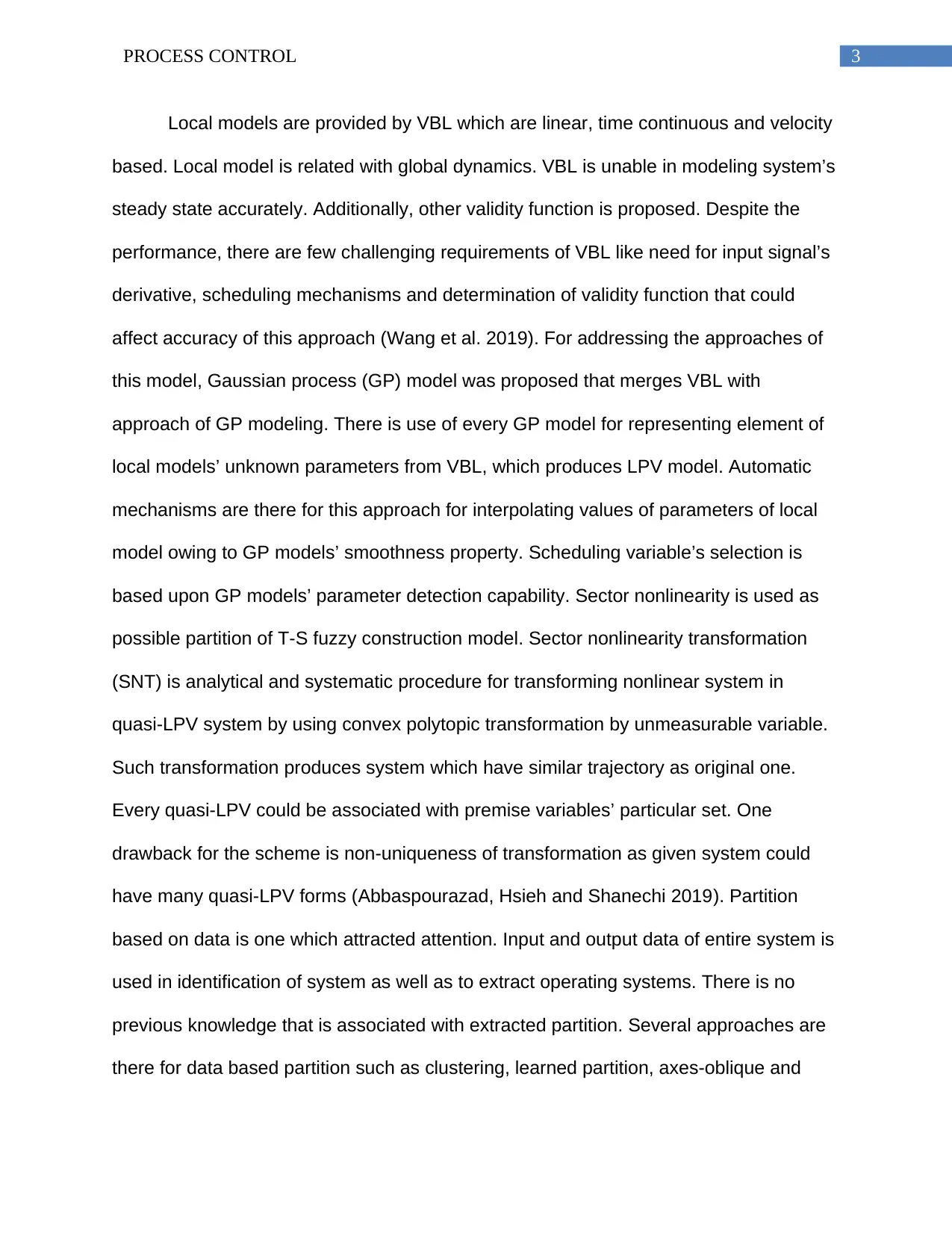
3PROCESS CONTROL
Local models are provided by VBL which are linear, time continuous and velocity
based. Local model is related with global dynamics. VBL is unable in modeling system’s
steady state accurately. Additionally, other validity function is proposed. Despite the
performance, there are few challenging requirements of VBL like need for input signal’s
derivative, scheduling mechanisms and determination of validity function that could
affect accuracy of this approach (Wang et al. 2019). For addressing the approaches of
this model, Gaussian process (GP) model was proposed that merges VBL with
approach of GP modeling. There is use of every GP model for representing element of
local models’ unknown parameters from VBL, which produces LPV model. Automatic
mechanisms are there for this approach for interpolating values of parameters of local
model owing to GP models’ smoothness property. Scheduling variable’s selection is
based upon GP models’ parameter detection capability. Sector nonlinearity is used as
possible partition of T-S fuzzy construction model. Sector nonlinearity transformation
(SNT) is analytical and systematic procedure for transforming nonlinear system in
quasi-LPV system by using convex polytopic transformation by unmeasurable variable.
Such transformation produces system which have similar trajectory as original one.
Every quasi-LPV could be associated with premise variables’ particular set. One
drawback for the scheme is non-uniqueness of transformation as given system could
have many quasi-LPV forms (Abbaspourazad, Hsieh and Shanechi 2019). Partition
based on data is one which attracted attention. Input and output data of entire system is
used in identification of system as well as to extract operating systems. There is no
previous knowledge that is associated with extracted partition. Several approaches are
there for data based partition such as clustering, learned partition, axes-oblique and
Local models are provided by VBL which are linear, time continuous and velocity
based. Local model is related with global dynamics. VBL is unable in modeling system’s
steady state accurately. Additionally, other validity function is proposed. Despite the
performance, there are few challenging requirements of VBL like need for input signal’s
derivative, scheduling mechanisms and determination of validity function that could
affect accuracy of this approach (Wang et al. 2019). For addressing the approaches of
this model, Gaussian process (GP) model was proposed that merges VBL with
approach of GP modeling. There is use of every GP model for representing element of
local models’ unknown parameters from VBL, which produces LPV model. Automatic
mechanisms are there for this approach for interpolating values of parameters of local
model owing to GP models’ smoothness property. Scheduling variable’s selection is
based upon GP models’ parameter detection capability. Sector nonlinearity is used as
possible partition of T-S fuzzy construction model. Sector nonlinearity transformation
(SNT) is analytical and systematic procedure for transforming nonlinear system in
quasi-LPV system by using convex polytopic transformation by unmeasurable variable.
Such transformation produces system which have similar trajectory as original one.
Every quasi-LPV could be associated with premise variables’ particular set. One
drawback for the scheme is non-uniqueness of transformation as given system could
have many quasi-LPV forms (Abbaspourazad, Hsieh and Shanechi 2019). Partition
based on data is one which attracted attention. Input and output data of entire system is
used in identification of system as well as to extract operating systems. There is no
previous knowledge that is associated with extracted partition. Several approaches are
there for data based partition such as clustering, learned partition, axes-oblique and
Paraphrase This Document
Need a fresh take? Get an instant paraphrase of this document with our AI Paraphraser
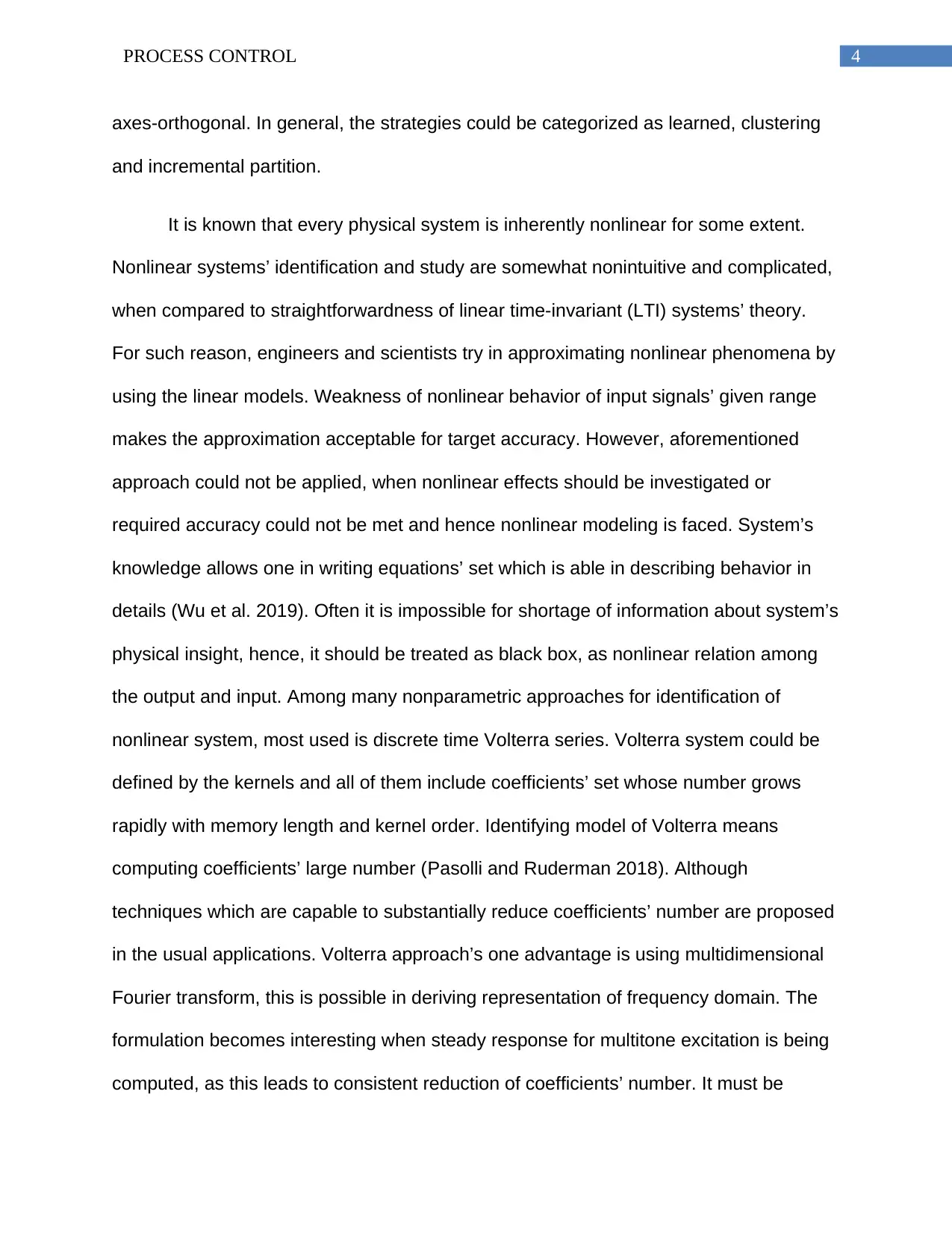
4PROCESS CONTROL
axes-orthogonal. In general, the strategies could be categorized as learned, clustering
and incremental partition.
It is known that every physical system is inherently nonlinear for some extent.
Nonlinear systems’ identification and study are somewhat nonintuitive and complicated,
when compared to straightforwardness of linear time-invariant (LTI) systems’ theory.
For such reason, engineers and scientists try in approximating nonlinear phenomena by
using the linear models. Weakness of nonlinear behavior of input signals’ given range
makes the approximation acceptable for target accuracy. However, aforementioned
approach could not be applied, when nonlinear effects should be investigated or
required accuracy could not be met and hence nonlinear modeling is faced. System’s
knowledge allows one in writing equations’ set which is able in describing behavior in
details (Wu et al. 2019). Often it is impossible for shortage of information about system’s
physical insight, hence, it should be treated as black box, as nonlinear relation among
the output and input. Among many nonparametric approaches for identification of
nonlinear system, most used is discrete time Volterra series. Volterra system could be
defined by the kernels and all of them include coefficients’ set whose number grows
rapidly with memory length and kernel order. Identifying model of Volterra means
computing coefficients’ large number (Pasolli and Ruderman 2018). Although
techniques which are capable to substantially reduce coefficients’ number are proposed
in the usual applications. Volterra approach’s one advantage is using multidimensional
Fourier transform, this is possible in deriving representation of frequency domain. The
formulation becomes interesting when steady response for multitone excitation is being
computed, as this leads to consistent reduction of coefficients’ number. It must be
axes-orthogonal. In general, the strategies could be categorized as learned, clustering
and incremental partition.
It is known that every physical system is inherently nonlinear for some extent.
Nonlinear systems’ identification and study are somewhat nonintuitive and complicated,
when compared to straightforwardness of linear time-invariant (LTI) systems’ theory.
For such reason, engineers and scientists try in approximating nonlinear phenomena by
using the linear models. Weakness of nonlinear behavior of input signals’ given range
makes the approximation acceptable for target accuracy. However, aforementioned
approach could not be applied, when nonlinear effects should be investigated or
required accuracy could not be met and hence nonlinear modeling is faced. System’s
knowledge allows one in writing equations’ set which is able in describing behavior in
details (Wu et al. 2019). Often it is impossible for shortage of information about system’s
physical insight, hence, it should be treated as black box, as nonlinear relation among
the output and input. Among many nonparametric approaches for identification of
nonlinear system, most used is discrete time Volterra series. Volterra system could be
defined by the kernels and all of them include coefficients’ set whose number grows
rapidly with memory length and kernel order. Identifying model of Volterra means
computing coefficients’ large number (Pasolli and Ruderman 2018). Although
techniques which are capable to substantially reduce coefficients’ number are proposed
in the usual applications. Volterra approach’s one advantage is using multidimensional
Fourier transform, this is possible in deriving representation of frequency domain. The
formulation becomes interesting when steady response for multitone excitation is being
computed, as this leads to consistent reduction of coefficients’ number. It must be
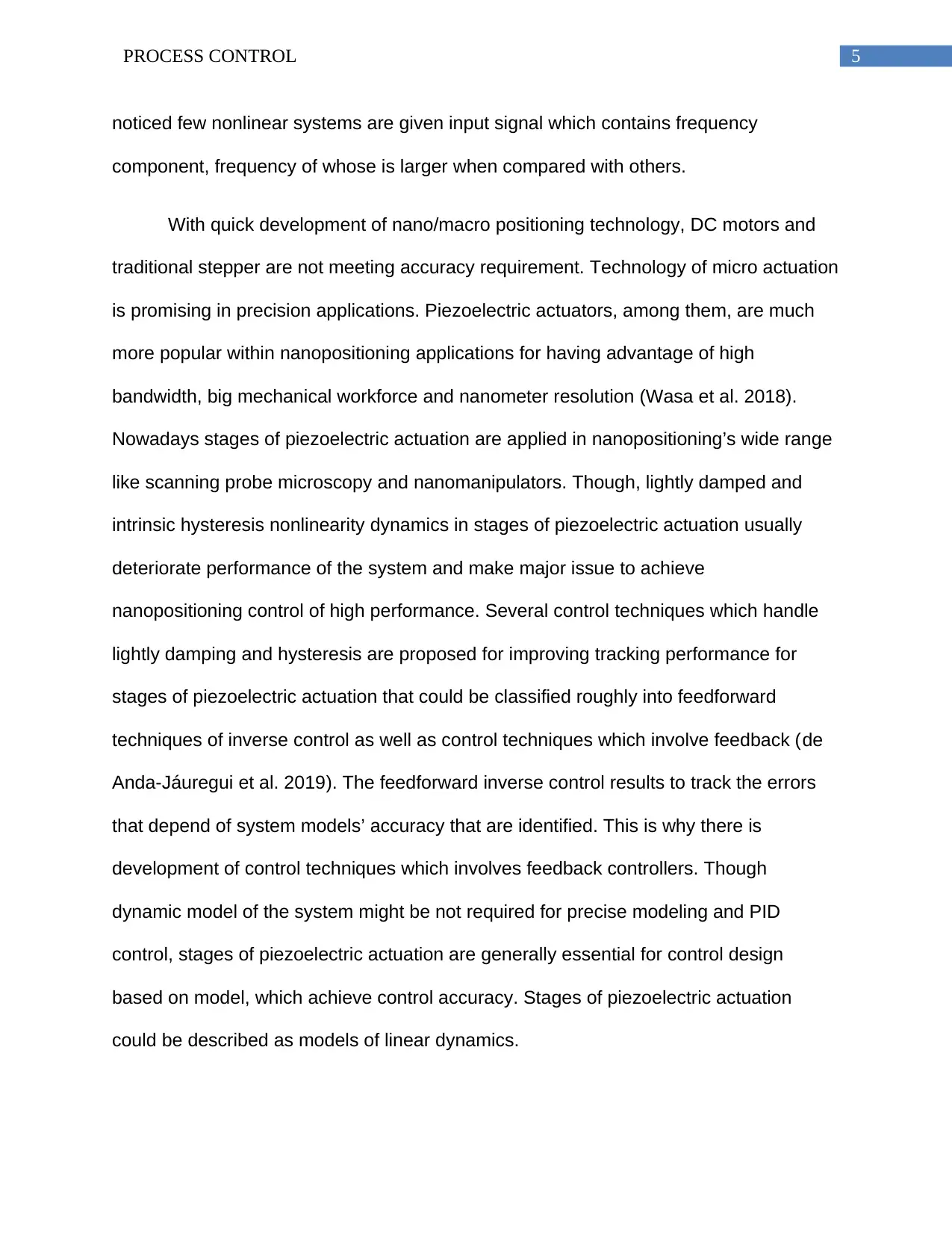
5PROCESS CONTROL
noticed few nonlinear systems are given input signal which contains frequency
component, frequency of whose is larger when compared with others.
With quick development of nano/macro positioning technology, DC motors and
traditional stepper are not meeting accuracy requirement. Technology of micro actuation
is promising in precision applications. Piezoelectric actuators, among them, are much
more popular within nanopositioning applications for having advantage of high
bandwidth, big mechanical workforce and nanometer resolution (Wasa et al. 2018).
Nowadays stages of piezoelectric actuation are applied in nanopositioning’s wide range
like scanning probe microscopy and nanomanipulators. Though, lightly damped and
intrinsic hysteresis nonlinearity dynamics in stages of piezoelectric actuation usually
deteriorate performance of the system and make major issue to achieve
nanopositioning control of high performance. Several control techniques which handle
lightly damping and hysteresis are proposed for improving tracking performance for
stages of piezoelectric actuation that could be classified roughly into feedforward
techniques of inverse control as well as control techniques which involve feedback (de
Anda-Jáuregui et al. 2019). The feedforward inverse control results to track the errors
that depend of system models’ accuracy that are identified. This is why there is
development of control techniques which involves feedback controllers. Though
dynamic model of the system might be not required for precise modeling and PID
control, stages of piezoelectric actuation are generally essential for control design
based on model, which achieve control accuracy. Stages of piezoelectric actuation
could be described as models of linear dynamics.
noticed few nonlinear systems are given input signal which contains frequency
component, frequency of whose is larger when compared with others.
With quick development of nano/macro positioning technology, DC motors and
traditional stepper are not meeting accuracy requirement. Technology of micro actuation
is promising in precision applications. Piezoelectric actuators, among them, are much
more popular within nanopositioning applications for having advantage of high
bandwidth, big mechanical workforce and nanometer resolution (Wasa et al. 2018).
Nowadays stages of piezoelectric actuation are applied in nanopositioning’s wide range
like scanning probe microscopy and nanomanipulators. Though, lightly damped and
intrinsic hysteresis nonlinearity dynamics in stages of piezoelectric actuation usually
deteriorate performance of the system and make major issue to achieve
nanopositioning control of high performance. Several control techniques which handle
lightly damping and hysteresis are proposed for improving tracking performance for
stages of piezoelectric actuation that could be classified roughly into feedforward
techniques of inverse control as well as control techniques which involve feedback (de
Anda-Jáuregui et al. 2019). The feedforward inverse control results to track the errors
that depend of system models’ accuracy that are identified. This is why there is
development of control techniques which involves feedback controllers. Though
dynamic model of the system might be not required for precise modeling and PID
control, stages of piezoelectric actuation are generally essential for control design
based on model, which achieve control accuracy. Stages of piezoelectric actuation
could be described as models of linear dynamics.
⊘ This is a preview!⊘
Do you want full access?
Subscribe today to unlock all pages.

Trusted by 1+ million students worldwide
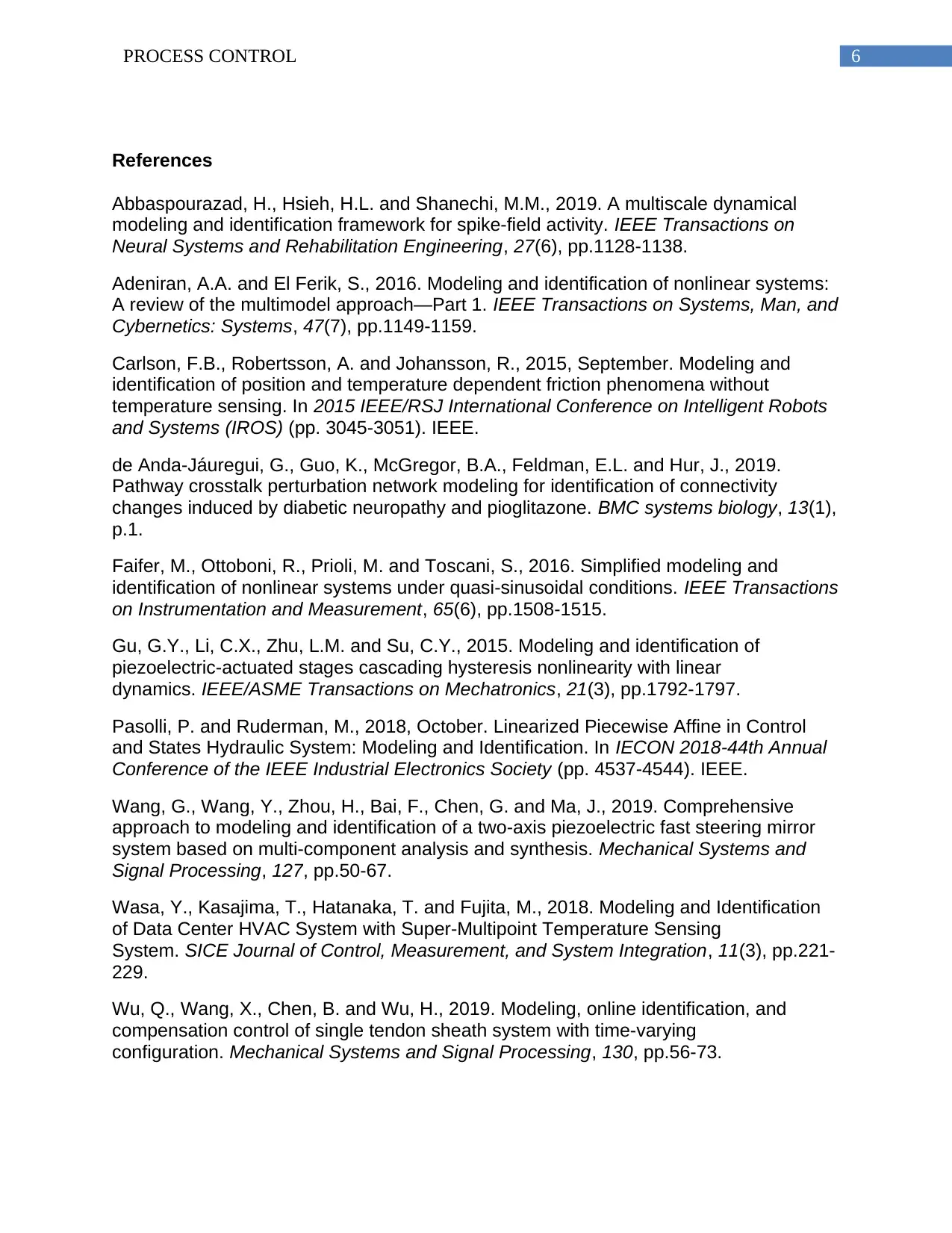
6PROCESS CONTROL
References
Abbaspourazad, H., Hsieh, H.L. and Shanechi, M.M., 2019. A multiscale dynamical
modeling and identification framework for spike-field activity. IEEE Transactions on
Neural Systems and Rehabilitation Engineering, 27(6), pp.1128-1138.
Adeniran, A.A. and El Ferik, S., 2016. Modeling and identification of nonlinear systems:
A review of the multimodel approach—Part 1. IEEE Transactions on Systems, Man, and
Cybernetics: Systems, 47(7), pp.1149-1159.
Carlson, F.B., Robertsson, A. and Johansson, R., 2015, September. Modeling and
identification of position and temperature dependent friction phenomena without
temperature sensing. In 2015 IEEE/RSJ International Conference on Intelligent Robots
and Systems (IROS) (pp. 3045-3051). IEEE.
de Anda-Jáuregui, G., Guo, K., McGregor, B.A., Feldman, E.L. and Hur, J., 2019.
Pathway crosstalk perturbation network modeling for identification of connectivity
changes induced by diabetic neuropathy and pioglitazone. BMC systems biology, 13(1),
p.1.
Faifer, M., Ottoboni, R., Prioli, M. and Toscani, S., 2016. Simplified modeling and
identification of nonlinear systems under quasi-sinusoidal conditions. IEEE Transactions
on Instrumentation and Measurement, 65(6), pp.1508-1515.
Gu, G.Y., Li, C.X., Zhu, L.M. and Su, C.Y., 2015. Modeling and identification of
piezoelectric-actuated stages cascading hysteresis nonlinearity with linear
dynamics. IEEE/ASME Transactions on Mechatronics, 21(3), pp.1792-1797.
Pasolli, P. and Ruderman, M., 2018, October. Linearized Piecewise Affine in Control
and States Hydraulic System: Modeling and Identification. In IECON 2018-44th Annual
Conference of the IEEE Industrial Electronics Society (pp. 4537-4544). IEEE.
Wang, G., Wang, Y., Zhou, H., Bai, F., Chen, G. and Ma, J., 2019. Comprehensive
approach to modeling and identification of a two-axis piezoelectric fast steering mirror
system based on multi-component analysis and synthesis. Mechanical Systems and
Signal Processing, 127, pp.50-67.
Wasa, Y., Kasajima, T., Hatanaka, T. and Fujita, M., 2018. Modeling and Identification
of Data Center HVAC System with Super-Multipoint Temperature Sensing
System. SICE Journal of Control, Measurement, and System Integration, 11(3), pp.221-
229.
Wu, Q., Wang, X., Chen, B. and Wu, H., 2019. Modeling, online identification, and
compensation control of single tendon sheath system with time-varying
configuration. Mechanical Systems and Signal Processing, 130, pp.56-73.
References
Abbaspourazad, H., Hsieh, H.L. and Shanechi, M.M., 2019. A multiscale dynamical
modeling and identification framework for spike-field activity. IEEE Transactions on
Neural Systems and Rehabilitation Engineering, 27(6), pp.1128-1138.
Adeniran, A.A. and El Ferik, S., 2016. Modeling and identification of nonlinear systems:
A review of the multimodel approach—Part 1. IEEE Transactions on Systems, Man, and
Cybernetics: Systems, 47(7), pp.1149-1159.
Carlson, F.B., Robertsson, A. and Johansson, R., 2015, September. Modeling and
identification of position and temperature dependent friction phenomena without
temperature sensing. In 2015 IEEE/RSJ International Conference on Intelligent Robots
and Systems (IROS) (pp. 3045-3051). IEEE.
de Anda-Jáuregui, G., Guo, K., McGregor, B.A., Feldman, E.L. and Hur, J., 2019.
Pathway crosstalk perturbation network modeling for identification of connectivity
changes induced by diabetic neuropathy and pioglitazone. BMC systems biology, 13(1),
p.1.
Faifer, M., Ottoboni, R., Prioli, M. and Toscani, S., 2016. Simplified modeling and
identification of nonlinear systems under quasi-sinusoidal conditions. IEEE Transactions
on Instrumentation and Measurement, 65(6), pp.1508-1515.
Gu, G.Y., Li, C.X., Zhu, L.M. and Su, C.Y., 2015. Modeling and identification of
piezoelectric-actuated stages cascading hysteresis nonlinearity with linear
dynamics. IEEE/ASME Transactions on Mechatronics, 21(3), pp.1792-1797.
Pasolli, P. and Ruderman, M., 2018, October. Linearized Piecewise Affine in Control
and States Hydraulic System: Modeling and Identification. In IECON 2018-44th Annual
Conference of the IEEE Industrial Electronics Society (pp. 4537-4544). IEEE.
Wang, G., Wang, Y., Zhou, H., Bai, F., Chen, G. and Ma, J., 2019. Comprehensive
approach to modeling and identification of a two-axis piezoelectric fast steering mirror
system based on multi-component analysis and synthesis. Mechanical Systems and
Signal Processing, 127, pp.50-67.
Wasa, Y., Kasajima, T., Hatanaka, T. and Fujita, M., 2018. Modeling and Identification
of Data Center HVAC System with Super-Multipoint Temperature Sensing
System. SICE Journal of Control, Measurement, and System Integration, 11(3), pp.221-
229.
Wu, Q., Wang, X., Chen, B. and Wu, H., 2019. Modeling, online identification, and
compensation control of single tendon sheath system with time-varying
configuration. Mechanical Systems and Signal Processing, 130, pp.56-73.
1 out of 7
Your All-in-One AI-Powered Toolkit for Academic Success.
+13062052269
info@desklib.com
Available 24*7 on WhatsApp / Email
![[object Object]](/_next/static/media/star-bottom.7253800d.svg)
Unlock your academic potential
Copyright © 2020–2025 A2Z Services. All Rights Reserved. Developed and managed by ZUCOL.


